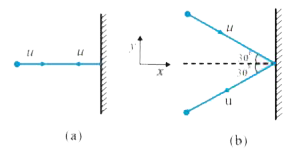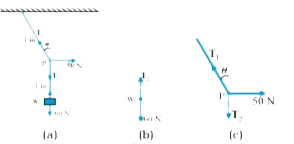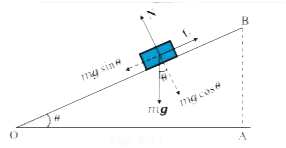Complete Solutions to EXAMPLE of chapter LAW OF MOTION of Class 11 book with complete answers and questions
| Class 11 | PHYSICS |
| Chapter | LAW OF MOTION |
| NCERT TELUGU | EXAMPLE |
| Number Of Questions | 12 |
| Academic Year | 2023-24 |
An astronaut accidentally gets separated out of his small spaceship accelerating in inter stellar space at a constant rate of `100 m s^(-2)` . What is the acceleration of the astronaut the instant after he is outside the spaceship ? (Assume that there are no nearby stars to exert gravitational force on him.)
View SolutionA bullet of mass 0.04 kg moving with a speed of `90 m s^(-1)` enters a heavy wooden block and is stopped after a distance of 60 cm. What is the average resistive force exerted by the block on the bullet?
View SolutionThe motion of a particle of mass m is described by `y = ut + 1/2 "gt"^2` . Find the force acting on the particle.
View SolutionA batsman hits back a ball straight in the direction of the bowler without changing its initial speed of` 12 m s^(-1)` . If the mass of the ball is 0.15 kg, determine the impulse imparted to the ball. (Assume linear motion of the ball)
View SolutionTwo identical billiard balls strike a rigid wall with the same speed but at different angles, and get reflected without any change in speed, as shown in Fig. 5.6. What is (i) the direction of the force on the wall due to each ball? (ii) the ratio of the magnitudes of impulses imparted to the balls by the wall ?

View SolutionSee Fig. A mass of 6 kg is suspended by a rope of length 2 m from the ceiling. A force of 50 N in the horizontal direction is applied at the mid- point P of the rope, as shown. What is the angle the rope makes with the vertical in equilibrium ? (Take `g = 10 m s^(-2)` ). Neglect the mass of the rope.

View SolutionDetermine the maximum acceleration of the train in which a box lying on its floor will remain stationary, given that the co-efficient of static friction between the box and the train’s floor is 0.15.
View SolutionSee Fig. A mass of 4 kg rests on a horizontal plane. The plane is gradually inclined until at an angle `theta = 15^@` with the horizontal, the mass just begins to slide. What is the coefficient of static friction between the block and the surface ?

View SolutionWhat is the acceleration of the block and trolley system shown in a Fig.(a), if the coefficient of kinetic friction between the trolley and the surface is 0.04? What is the tension in the string? (Take g =` 10 m s^(-2)` ). Neglect the mass of the string.

View SolutionA cyclist speeding at 18 km/h on a level road takes a sharp circular turn of radius 3 m without reducing the speed. The co-efficient of static friction between the tyres and the road is 0.1. Will the cyclist slip while taking the turn?
View SolutionA circular racetrack of radius 300 m is banked at an angle of `15^@` . If the coefficient of friction between the wheels of a race-car and the road is 0.2, what is the (a) optimum speed of the race- car to avoid wear and tear on its tyres, and (b) maximum permissible speed to avoid slipping ?
View SolutionA wooden block of mass 2 kg rests on a soft horizontal floor. When an iron cylinder of mass 25 kg is placed on top of the block, the floor yields steadily and the block and the cylinder together go down with an acceleration of` 0.1 m s^(-2)`. What is the action of the block on the floor (a) before and (b) after the floor yields ? Take g = `10 m s^(-2)` . Identify the action-reaction pairs in the problem.
View Solution
EXAMPLE questions and complete solutions for chapter LAW OF MOTION of NCERT PHYSICS(TELUGU) of Class 11